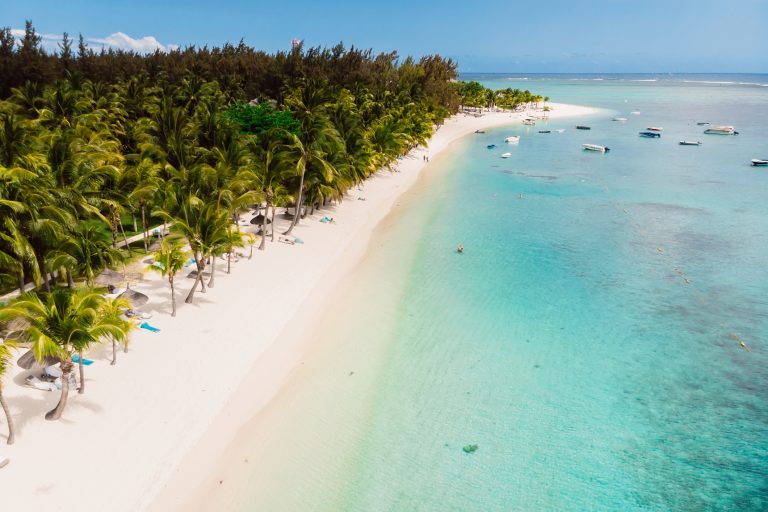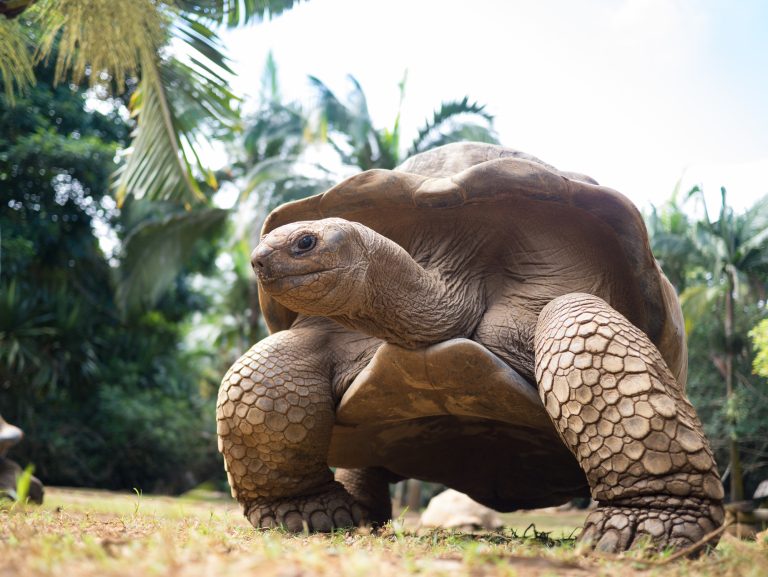Nature conservation
Mauritius
Rare tortoise in need
A human protective shell for the Aldabra tortoise
Mauritius stands for turquoise blue sea, white sandy beaches and evergreen nature. In order to preserve the rich heritage of the Indian Ocean Island, sustainability is a top priority. Mauritius has set itself the goal of achieving the status “Green Destination” by 2030. Unfortunately, Mauritius also stands for a sad record: more species have become extinct here than anywhere else on earth. What counts now is to do everything in our power to save the species that still exist – the turtles, for example.
Before humans colonised the islands in the Indian Ocean, there was a large population of different turtle species. When humans arrived, turtles served as a source of food. The domestic animals they brought with them led to a huge loss among the armoured animals through the killing of young.

Today, only one species of turtle still exists on Mauritius and the neighbouring islands: the giant Aldabra turtle. But it is also endangered.
Armoured animals play a decisive role in the balance of island nature, as they also provide for seed dispersal when grazing on land. For instance, they eat the fruits of the ebony tree and spread the seeds via their excretions, thus promoting the natural spread of threatened trees. Since as early as 2000, attempts have been made to settle and propagate the Aldabra on Mauritius and the neighbouring islands. At first, this initiative got off to a good start: the turtles reproduced diligently, the protection of their young was ensured.
Then, in July 2020, there was a shipwreck off the south-east coast of Mauritius that caused an oil spill of around 30 square kilometres. Its toxic fumes threatened, among others, the Aldabra turtles residing on the beaches.
While international aid was slow to arrive following the accident, DER Touristik Foundation quickly became active and found a suitable partner in the Mauritian Wildlife Foundation (MWF) to promote the rescue of the Aldabra. The Ile aux Aigrettes in particular faced a direct threat, the island of the great white egrets, a nature reserve of the MWF.
Since then, the DER Touristik Foundation has been supporting a project to guarantee the continued existence of the Aldabra turtles.
For this purpose, Aldabra babies are protected and reared under observation on a specially established turtle farm on the island – away from the oil fumes. Besides sufficient food and weight checks, they also receive regular medical check-ups. After two years, the Aldabra offspring is now big and strong enough to set out into the wild on its own. The armoured giants make an invaluable contribution towards restoring the ecological balance of the island reserve.

A glance behind the scenes
The lighthouse project “Sustainable Island Mauritius” (SIM) funded by the EU focuses on promoting sustainable tourism in Mauritius. Sustainable excursions have been offered under the name “The Wise Dodo” since 2018, co-designed by DER Touristik. The mysterious land bird Dodo once lived in Mauritius but became extinct 300 years ago and is now being brought to life again as a symbol of a campaign to deliver unique Mauritius experiences.
As part of an excursion from “The Wise Dodo” programme, holidaymakers get acquainted with the turtle conservation project supported by the DER Touristik Foundation and the “Aldabra Baby Farm” on Ile aux Aigrettes. A MWF member of staff accompanies guests and provides a plethora of insights into both the armoured residents and their habitat as well as nature and species conservation on Mauritius in general. May the turtles, unlike the dodo, survive in Mauritius!
Our cooperation partner:
Mauritian Wildlife Foundation (MWF)
The largest non-governmental organisation in Mauritius deals exclusively with the protection and conservation of endangered plant and animal species on the main island and offshore islands. MWF works closely with local and international partners on practical conservation projects. The long-term goal: re-establish destroyed and threatened ecosystems such as native rainforests and save endangered animal and plant species from extinction.
